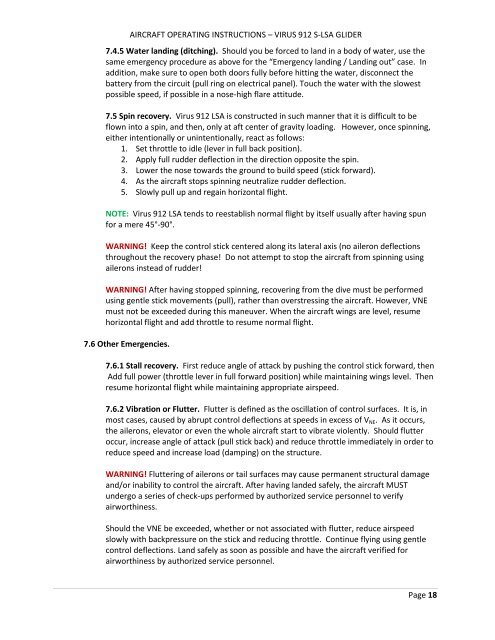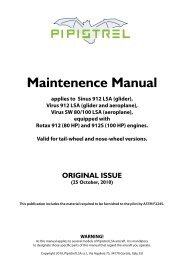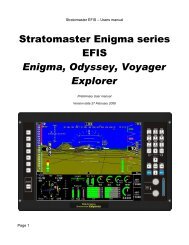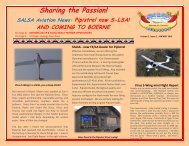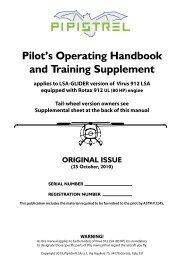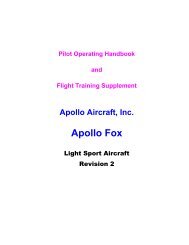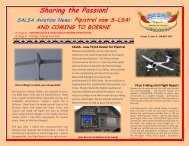Pipistrel Virus Aircraft Operating Instruction - Salsa Aviation
Pipistrel Virus Aircraft Operating Instruction - Salsa Aviation
Pipistrel Virus Aircraft Operating Instruction - Salsa Aviation
You also want an ePaper? Increase the reach of your titles
YUMPU automatically turns print PDFs into web optimized ePapers that Google loves.
AIRCRAFT OPERATING INSTRUCTIONS – VIRUS 912 S-LSA GLIDER7.4.5 Water landing (ditching). Should you be forced to land in a body of water, use thesame emergency procedure as above for the “Emergency landing / Landing out” case. Inaddition, make sure to open both doors fully before hitting the water, disconnect thebattery from the circuit (pull ring on electrical panel). Touch the water with the slowestpossible speed, if possible in a nose-high flare attitude.7.5 Spin recovery. <strong>Virus</strong> 912 LSA is constructed in such manner that it is difficult to beflown into a spin, and then, only at aft center of gravity loading. However, once spinning,either intentionally or unintentionally, react as follows:1. Set throttle to idle (lever in full back position).2. Apply full rudder deflection in the direction opposite the spin.3. Lower the nose towards the ground to build speed (stick forward).4. As the aircraft stops spinning neutralize rudder deflection.5. Slowly pull up and regain horizontal flight.NOTE: <strong>Virus</strong> 912 LSA tends to reestablish normal flight by itself usually after having spunfor a mere 45°-90°.WARNING! Keep the control stick centered along its lateral axis (no aileron deflectionsthroughout the recovery phase! Do not attempt to stop the aircraft from spinning usingailerons instead of rudder!WARNING! After having stopped spinning, recovering from the dive must be performedusing gentle stick movements (pull), rather than overstressing the aircraft. However, VNEmust not be exceeded during this maneuver. When the aircraft wings are level, resumehorizontal flight and add throttle to resume normal flight.7.6 Other Emergencies.7.6.1 Stall recovery. First reduce angle of attack by pushing the control stick forward, thenAdd full power (throttle lever in full forward position) while maintaining wings level. Thenresume horizontal flight while maintaining appropriate airspeed.7.6.2 Vibration or Flutter. Flutter is defined as the oscillation of control surfaces. It is, inmost cases, caused by abrupt control deflections at speeds in excess of V NE . As it occurs,the ailerons, elevator or even the whole aircraft start to vibrate violently. Should flutteroccur, increase angle of attack (pull stick back) and reduce throttle immediately in order toreduce speed and increase load (damping) on the structure.WARNING! Fluttering of ailerons or tail surfaces may cause permanent structural damageand/or inability to control the aircraft. After having landed safely, the aircraft MUSTundergo a series of check-ups performed by authorized service personnel to verifyairworthiness.Should the VNE be exceeded, whether or not associated with flutter, reduce airspeedslowly with backpressure on the stick and reducing throttle. Continue flying using gentlecontrol deflections. Land safely as soon as possible and have the aircraft verified forairworthiness by authorized service personnel.Page 18


